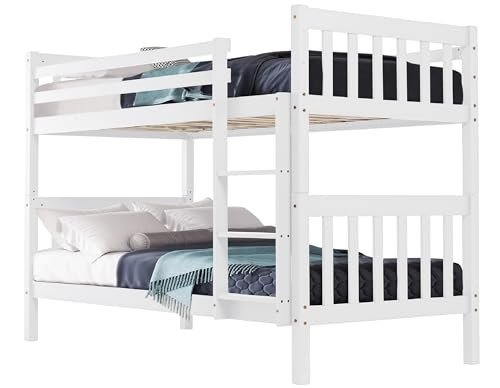Exploring Bunk Beds: A Comprehensive Guide
Bunk beds have actually long been a staple in kids's bedrooms, dorms, and even homes with limited space. Not just do they supply a useful sleeping service, but they also create a fun and creative environment for children and a great space-saver for adults and households. This short article will check out everything you need to understand about bunk beds, from types and materials to security pointers and buying advice.
Table of Contents
- Types of Bunk Beds
- Standard Bunk Beds
- Loft Beds
- Triple Bunk Beds
- L-Shaped Bunk Beds
- Product Options
- Wood
- Metal
- Safety Considerations
- Buying Guide
- FAQs
Types of Bunk Beds
Bunk beds are available in various styles to suit different needs and preferences. Here's a breakdown of the most common types:
Conventional Bunk Beds
Traditional bunks generally include two beds stacked vertically on top of one another. These beds are ideal for brother or sisters sharing a room or for taking full advantage of sleeping space in guest spaces.
Loft Beds
Loft beds stand likewise to traditional bunk beds however do not have a lower sleeping location. Rather, they frequently include a desk or seating location underneath, making them a great option for little rooms requiring multifunctionality.
Triple Bunk Beds
Triple bunk beds are created for three occupants, with beds stacked in a three-tier configuration. These are less common but can be an enjoyable option for large families or sleepovers.
L-Shaped Bunk Beds
With one bed positioned horizontally and the other vertically, L-shaped bunk beds are typically geared up with additional features such as desks or storage drawers and can match corner areas in a room.
Comparison of Bunk Bed Types
| Bed Type | Ideal Use | Description |
|---|---|---|
| Conventional | Shared bed rooms or guest spaces | Two beds stacked vertically |
| Loft | Small rooms requiring multi-purpose space | Upper bed with open space beneath |
| Triple | Big families or slumber parties | 3 beds stacked vertically |
| L-Shaped | Corner or versatile areas | A mix of vertical and horizontal beds |
Material Options
Bunk beds are produced from various materials, with wood and metal being the most typical. Each material has its advantages and disadvantages.
Wood
- Resilience: Generally robust and can endure years of usage.
- Visual Appeal: Offers a traditional look that can mix with various decorations.
- Weight Capacity: Typically sturdier; can support much heavier weights.
- Drawbacks: May be more costly than metal alternatives and can be prone to scratches.
Metal
- Sturdiness: Generally light-weight and easy to move however still sturdy.
- Modern Design: Often comes in streamlined styles, making it appealing for contemporary areas.
- Affordable: Usually less costly than wood choices.
- Downsides: Can be cold to the touch in winter seasons and might not have the exact same visual appeal for some purchasers.
Safety Considerations
When it comes to bunk beds, safety can not be neglected. Here are key security ideas to keep in mind:
- Guardrails: Ensure that the leading bunk has guardrails on both sides to prevent falls.
- Strong Construction: Check for a strong develop and sturdy products to withstand weight and motion.
- Weight Limit: Adhere to the producer's weight limitation for both the upper and lower bunks.
- Ladder Design: Choose bunks with a safe, easy-to-climb ladder and prevent any sharp edges or rungs.
- Age Restrictions: Most makers advise that children under the age of 6 ought to not sleep in the upper bunk.
Buying Guide
When searching for bunk beds, think about the following factors to find the best fit for your requirements:
- Space Availability: Measure the space size and ceiling height, guaranteeing there is sufficient space for the top bunk.
- Bed Size: Decide between twin, full, or larger sizes based upon your needs and the size of the space.
- Design Preference: Consider the overall design of the bed room to discover an ideal style.
- Reduce of Setup: Look for a bunk bed that is uncomplicated to put together.
- Spending plan: Bunk beds are available in numerous price ranges, so identify a budget before beginning your search.
FAQs
1. What is the recommended age for kids to sleep on the leading bunk?
Kids aged six and older are typically suggested to sleep on the leading bunk to lessen the threat of falls.
2. How can I make my bunk bed more secure?
To boost security, make sure guardrails are properly installed and inspect that the bed is put on a flat surface. Additionally, motivate kids to utilize the ladder carefully.
3. Can I convert a bunk bed into two different beds?
Many bunk beds are developed to be convertible. Check the maker's requirements for convertibility features.
4. What Adult Bunk Bed leonkahawai.top are offered for bunk beds?
Common devices include beddings, storage drawers, staircases instead of ladders, and tented canopies for an enjoyable visual appeal.
5. How do I keep my bunk bed?
Regular look for loose screws or structural integrity can help guarantee safety. Dust the bed routinely and clean spills immediately to keep the materials in good condition.
Bunk beds are versatile and a space-efficient option for different living circumstances, from children's rooms to guest lodgings. With numerous styles and materials offered, potential purchasers have a wealth of choices to think about, making sure a combination of practicality and looks. By focusing on safety and following the tips described in this guide, individuals can discover the right bunk bed that fits their space and way of life, all while developing an enjoyable sleeping environment.

